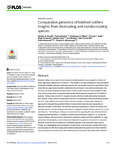Comparative genomics of bdelloid rotifers: insights from desiccating and non-desiccating species
| dc.contributor.author | Nowell, R | |
| dc.contributor.author | Almeida, P | |
| dc.contributor.author | Wilson, C | |
| dc.contributor.author | Smith, T | |
| dc.contributor.author | Fontaneto, D | |
| dc.contributor.author | Crisp, A | |
| dc.contributor.author | Micklem, G | |
| dc.contributor.author | Tunnacliffe, A | |
| dc.contributor.author | Boschetti, Chiara | |
| dc.contributor.author | Barraclough, T | |
| dc.date.accessioned | 2018-04-20T10:28:33Z | |
| dc.date.issued | 2018-04-24 | |
| dc.identifier.issn | 1544-9173 | |
| dc.identifier.issn | 1545-7885 | |
| dc.identifier.other | e2004830 | |
| dc.identifier.uri | http://hdl.handle.net/10026.1/11307 | |
| dc.description.abstract |
Bdelloid rotifers are a class of microscopic invertebrates that have existed for millions of years apparently without sex or meiosis. They inhabit a variety of temporary and permanent freshwater habitats globally, and many species are remarkably tolerant of desiccation. Bdelloids offer an opportunity to better understand the evolution of sex and recombination, but previous work has emphasised desiccation as the cause of several unusual genomic features in this group. Here, we present high-quality whole-genome sequences of 3 bdelloid species: Rotaria macrura and R. magnacalcarata, which are both desiccation intolerant, and Adineta ricciae, which is desiccation tolerant. In combination with the published assembly of A. vaga, which is also desiccation tolerant, we apply a comparative genomics approach to evaluate the potential effects of desiccation tolerance and asexuality on genome evolution in bdelloids. We find that ancestral tetraploidy is conserved among all 4 bdelloid species, but homologous divergence in obligately aquatic Rotaria genomes is unexpectedly low. This finding is contrary to current models regarding the role of desiccation in shaping bdelloid genomes. In addition, we find that homologous regions in A. ricciae are largely collinear and do not form palindromic repeats as observed in the published A. vaga assembly. Consequently, several features interpreted as genomic evidence for long-term ameiotic evolution are not general to all bdelloid species, even within the same genus. Finally, we substantiate previous findings of high levels of horizontally transferred nonmetazoan genes in both desiccating and nondesiccating bdelloid species and show that this unusual feature is not shared by other animal phyla, even those with desiccation-tolerant representatives. These comparisons call into question the proposed role of desiccation in mediating horizontal genetic transfer. | |
| dc.format.extent | 0-0 | |
| dc.format.medium | Electronic-eCollection | |
| dc.language | en | |
| dc.language.iso | en | |
| dc.publisher | Public Library of Science | |
| dc.subject | Adaptation, Physiological | |
| dc.subject | Animals | |
| dc.subject | Desiccation | |
| dc.subject | Ecosystem | |
| dc.subject | Fresh Water | |
| dc.subject | Gene Transfer, Horizontal | |
| dc.subject | Genetic Speciation | |
| dc.subject | Genome, Helminth | |
| dc.subject | Genomics | |
| dc.subject | Phylogeny | |
| dc.subject | Rotifera | |
| dc.subject | Synteny | |
| dc.subject | Tetraploidy | |
| dc.subject | Whole Genome Sequencing | |
| dc.title | Comparative genomics of bdelloid rotifers: insights from desiccating and non-desiccating species | |
| dc.type | journal-article | |
| dc.type | Comparative Study | |
| dc.type | Journal Article | |
| dc.type | Research Support, Non-U.S. Gov't | |
| plymouth.author-url | https://www.webofscience.com/api/gateway?GWVersion=2&SrcApp=PARTNER_APP&SrcAuth=LinksAMR&KeyUT=WOS:000431480000020&DestLinkType=FullRecord&DestApp=ALL_WOS&UsrCustomerID=11bb513d99f797142bcfeffcc58ea008 | |
| plymouth.issue | 4 | |
| plymouth.volume | 16 | |
| plymouth.publication-status | Published online | |
| plymouth.journal | PLoS Biology | |
| dc.identifier.doi | 10.1371/journal.pbio.2004830 | |
| plymouth.organisational-group | /Plymouth | |
| plymouth.organisational-group | /Plymouth/Faculty of Science and Engineering | |
| plymouth.organisational-group | /Plymouth/Faculty of Science and Engineering/School of Biological and Marine Sciences | |
| plymouth.organisational-group | /Plymouth/REF 2021 Researchers by UoA | |
| plymouth.organisational-group | /Plymouth/REF 2021 Researchers by UoA/UoA06 Agriculture, Veterinary and Food Science | |
| plymouth.organisational-group | /Plymouth/Users by role | |
| plymouth.organisational-group | /Plymouth/Users by role/Academics | |
| dc.publisher.place | United States | |
| dcterms.dateAccepted | 2018-02-20 | |
| dc.identifier.eissn | 1545-7885 | |
| dc.rights.embargoperiod | Not known | |
| rioxxterms.funder | Biotechnology and Biological Sciences Research Council | |
| rioxxterms.identifier.project | Eighty million years without sex: the role of genome structure in bdelloid rotifers | |
| rioxxterms.versionofrecord | 10.1371/journal.pbio.2004830 | |
| rioxxterms.licenseref.uri | http://www.rioxx.net/licenses/all-rights-reserved | |
| rioxxterms.licenseref.startdate | 2018-04-24 | |
| rioxxterms.type | Journal Article/Review | |
| plymouth.funder | Eighty million years without sex: the role of genome structure in bdelloid rotifers::Biotechnology and Biological Sciences Research Council |


